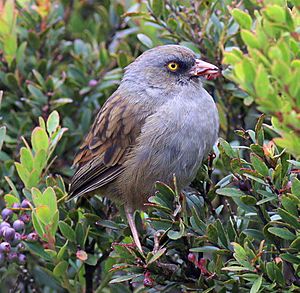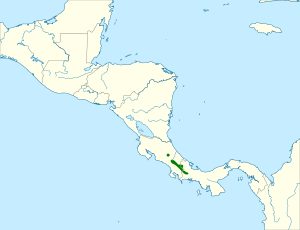Volcano junco facts for kids
Quick facts for kids Volcano junco |
|
|---|---|
 |
|
| In Cerro de la Muerte, Costa Rica | |
| Conservation status | |
| Scientific classification | |
| Genus: |
Junco
|
| Species: |
vulcani
|
 |
|
The volcano junco (Junco vulcani) is a small bird that belongs to the New World sparrow family. It lives only in the Talamancan montane forests of Costa Rica and western Panama. This means you won't find it naturally anywhere else in the world!
Contents
Where the Volcano Junco Lives
This special bird likes to live high up in the mountains. It usually breeds above the tree line, which is typically higher than 3,000 meters (about 9,800 feet). Imagine living that high!
There's also a group of these birds living a bit lower, at 2,100 meters (about 6,900 feet), on the Caribbean side of Costa Rica. Sometimes, when forests are cleared, like on Cerro de la Muerte, these birds can move down to 2,600 meters (about 8,500 feet).
Their favorite places to live are open areas with grass or small bushes, and sometimes a few short, twisted trees.
What the Volcano Junco Looks Like
The volcano junco is about 16 centimeters (6.3 inches) long. That's about the length of a regular pencil! It weighs around 28 grams, which is about the same as a few quarters.
Its back and upper parts are brown, with darker stripes, especially on its back. Its wings and tail feathers have dark edges. The underside of its body is grey.
The sides of its head are also grey, and it has a black mask that goes across its eyes. Its eyes are yellow, and its beak and legs are pink. Young volcano juncos are a brighter brown on top with more black stripes. Their undersides are a buff-grey color.
Sounds and Songs
Volcano juncos make different sounds. One call is a thin tseee. Another is a clearer wheew.
When they sing, it's a mix of squeaky and buzzing sounds. Their song might sound like k’chew chu k’wee chip chip chueee.
What the Volcano Junco Eats
These birds find their food on the ground. They eat seeds, berries that have fallen, insects, and spiders.
They move around by running and hopping. They usually only fly for short distances.
Life Cycle and Nesting
The volcano junco builds a very neat, cup-shaped nest. They make it on the ground, often hidden under a log, a bush, or a rock. Sometimes, they build their nests in a small hole on a bank covered with plants.
The female volcano junco lays two eggs. These eggs are pale blue and have brown spots on them.
See also
 In Spanish: Junco de los volcanes para niños
In Spanish: Junco de los volcanes para niños


